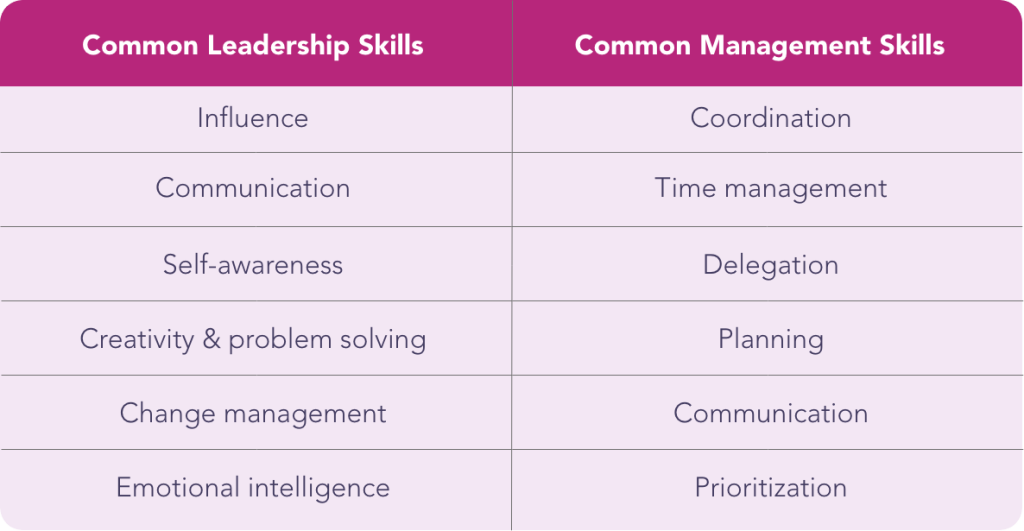
While the terms leadership and management are often used interchangeably, there is an important distinction between the two. In a thriving business, leaders set the vision, inspiring and influencing others as they drive change and action through a shared purpose and clear direction. Managers focus on the day-to-day operations and practical aspects of running an organization by planning and coordinating resources to achieve objectives.
To be effective in these roles, staff need to develop a set of distinct skills while also being mindful of the needs of the multigenerational workforce. Learning & Development teams: Take note of the core competencies and expectations that are reshaping these positions to elevate leadership and management inside your organization.
A Snapshot of Priority Skills
While the chart above is not exhaustive of all the capabilities appreciated in each position, it offers a high-level overview of the essentials. I’ll call attention to a few of those needs for leaders, including:
- Emotional intelligence (EQ), which emphasizes self-awareness, self-regulation, empathy and social skills. High EQ boosts a person’s ability to connect with team members on an authentic level, promoting trust and collaboration.
- Strategic thinking. Leaders of an organization can see the big picture, anticipate future challenges and opportunities as well as develop long-term approaches to navigate them.
- Communication. It’s vital to be able to articulate a clear vision to inspire others as well as facilitate open and honest dialogue to engage and influence employees.
- Change management. Leaders often face unexpected challenges along the way to their desired future state. Addressing these frequent shifts requires creativity and resilience.
For more insights into in-demand capabilities, be sure to download our recent guide:
Great supervisors may also be effective leaders and vice versa, so there is often overlap in their proficiencies. However, management requires its own set of competencies to ensure teams operate productively, including:
- Coordination. Strong managers are adept at creating structured work environments where priorities are clearly identified, resources are allocated appropriately and deadlines are met.
- Communication. It’s essential that individuals in these roles can offer direction on goals and assignments while also delivering feedback and taking in employee input to optimize execution.
- Delegation. Understanding who on the team is best equipped to meet different objectives and who may benefit from various on-the-job learning opportunities separates a good supervisor from a great one.
- Planning. Effective managers can translate a strategic vision into specific action steps as well as proactively problem-solve as they identify challenges along the way.
When Learning & Development teams prioritize these requisite capacities in their training programs, managers and leaders will gain a solid foundation to shape their styles and advance the organization. These programs can further be elevated by exploring what each generation may want from their supervisors and executives.
Generational Perspectives on Leadership
Baby Boomers typically value capable, strategic and admirable leaders. Often, they are not looking for a hands-on partner. Instead, they may see this role as a beacon, guiding the way toward where the organization is heading, and appreciate a mindset that focuses on results and proven capabilities.
Gen X tends to appreciate leaders who serve as role models. They commonly seek someone who will walk the talk of the company, is approachable and open to new ideas. They may value executives who show up with strength in challenging moments, while allowing for independent problem-solving day-to-day.
Millennials typically look for a collaborative, participatory and purpose-driven approach from those they choose to follow. They tend to seek out workplaces that offer meaning and align with broader societal goals. It’s also important that they feel they are part of the team and can share their ideas.
Gen Z is usually eager to have their voices heard and is often engaged by directors who cultivate a sense of belonging and an inclusive workspace. They value EQ and humility to a high degree, so it’s no surprise then that younger generations are less won over by charisma than those of an older generation.
The Application for Training
Many of the core skills I identified already do translate across generations. To amplify learning initiatives, share multigenerational insights and help participants consider how their leadership styles will:
- Embrace employee voice
- Communicate and align with corporate values
- Balance approachability with a sense of gravitas
- Recognize different triggers to indicate what role their people may need them to play (e.g., coach, empathizer, tactician)
Generational Expectations of Management
Baby Boomers often value managers who provide clear communication and respect the experience individual contributors bring to the team. They may prefer approaches emphasizing appreciation for their performance and opportunities for ongoing advancement.
Gen X employees commonly gravitate toward supervisors who are pragmatic, results-oriented and communicate directly. They often value team leads who give them the flexibility and trust to accomplish work on their terms.
Millennials tend to prefer managers who can serve as coaches and mentors. They are eager for ongoing communication, regular feedback and opportunities to share ideas so they can make an impact on their colleagues.
Gen Z employees typically look for team leads who care about their distinct needs and interests as well as create inclusive work environments. They generally appreciate work-life balance and a proactive style that helps them effectively cope with their workload.
And while it’s often said that younger generations want flexibility and ongoing development, these interests are shared by every generation.
The Application for Training
Again, the primary management skills I’ve highlighted and the interests of cross-generational staff coincide. A few elements that can elevate development programs include a focus on:
- Planning and coordination in a flexible work environment
- Creating on-the-job learning opportunities
- Optimizing communication and feedback delivery
- Finding the balance between hands-on and hands-off support
There is more to an individual beyond their generation; each person has their own interests, which will shape the way they want to be managed and led. When executives and supervisors focus on learning about their staff’s preferences and aim to meet in the middle, they will be able to match rapport and support employees in ways that are more likely to transcend age groups.
Looking for support to optimize your leadership and management training? Learn how Thinking and Behavioral insights can help your directors and supervisors differentiate their approach and maximize results. Explore our website or fill out the form below to speak with one of our team members today.
 Print This Post
Print This Post


